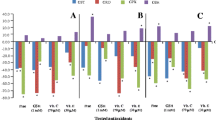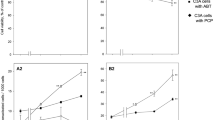Abstract
The clastogenic effect ofN-methyl-N′-nitro-N-nitrosoguanidine (MNNG) in Chinese hamster ovary (CHO) cells and its modulation by Na2SeO3 and caffeine were studied by metaphase analysis of chromosome aberrations (CA) as well as by measuring the formation and repair of single-strand (ss) DNA breaks employing hydroxylapatite chromatography. Treatment of CHO cells with MNNG (1.25 or 2.5 × 10-5M) for 3 h caused CA in 11 and 19% of metaphases scored, respectively. Pretreatment of cells with Na2SeO3 (1–5 μg/mL) or caffeine (0.2–2.0 mg/mL) for 2 h resulted in a 2–3.5-fold increase of CA frequency. Addition of both modulators during the mutagen exposure tended to cause a slight inhibition of clastogenic activity of MNNG (1.25 × 10−5 M) or had no effect on CA number when MNNG was used at a concentration of 2.5 × 10−5M. Posttreatment of CHO cells with Na2SeO3 for 20 h after MNNG was ineffective in influencing the number of metaphases with CA, whereas, at these conditions, caffeine enhanced up to 6-7-fold the clastogenic activity of MNNG. Addition of both modulators during the whole experiment, 2 h pretreatment included, resulted in a further significant increase of CA frequency up to the total pulverization of chromosomes in all metaphases scored. The coclastogenic effect of caffeine was greater in this case. The enhancement of chromosome-damaging activity of MNNG by selenite and caffeine was better expressed when this carcinogen was applied at the higher concentration used. An additive coclastogenic effect was observed in CHO cells treated simultaneously with Na2SeO3 and caffeine plus MNNG. In addition, the treatment of CHO cells with MNNG (5 × 10−6 M) caused a rapid increase of ssDNA breaks number reaching maximal values after 30–45 min. However, up to 50–60% of MNNG-induced ssDNA breaks were repaired during the first 60–150 min after the mutagen exposure. The 2 h pretreatment of CHO cells with Na2SeO3 (2 μg/mL) or the addition of this trace element after MNNG had no effect on formation and repair of MNNG-induced ssDNA breaks. The coclastogenic effect of Na2SeO3 in CHO cells treated with MNNG was not directly linked to the induction and disappearance of ssDNA breaks measured by hydroxylapatite chromatography.
Similar content being viewed by others
References
R. Shamberger,Mutat. Res. 154, 29–48 (1985).
C. W. Boone, G. J. Kelloff, and W. E. Malone,Cancer Res. 50, 2–9 (1990).
L. Lo, J. Koropatnick, and H. Stick,Mutat. Res. 49, 305–312 (1978).
G. Lofroth, and B. Ames,Mutat. Res. 53, 65–66 (1978).
M. Noda, T. Takano, and H. Sakurai,Mutat. Res. 66, 175–179 (1979).
R. Witting, L. Wei, and H. Stich,Mutat. Res. 78, 159–169 (1980).
S. Siriani, and C. Huang,Cancer Lett. 18, 109–116 (1983).
R. M. Balansky, P. M. Blagoeva, and Z. Mircheva,Biol. Trace Element Res. 5, 331–343 (1983).
R. Balansky,Mutat. Res. 269, 307–317 (1992).
D. Boothman, R. Schlegel, and A. Pardee,Mutat. Res. 202, 393–411 (1988).
IARC Monographs, vol. 51 IARC, Lyon (1991).
R. M. Balansky,Mutat. Res. 263, 231–236 (1991).
B. Rydberg,Radiation Biol. 61, 274–287 (1975).
I. Ceccherini, N. Loprieno, and I. Sbrana,Mutagenesis 3, 39–44 (1988).
A. Lehmann, and S. Kirk-Bell,Mutat. Res. 26, 73–82 (1974).
B. Kihlman,Caffeine and Chromosomes, Elsevier, Amsterdam (1977).
K. Hansson, B. Kihlman, C. Tanzarella, and F. Palitti,Mutat. Res. 126, 251–258 (1984).
A. Gonzalez-Fernandez, P. Hernandez, and J. Lopez-Saez,Mutat. Res. 149, 275–281 (1985).
R. Goth-Goldstein, and R. Painter,Carcinogenesis,2, 1267–1271 (1981).
C. C. Lau, and A. Pardee,Proc. Natl. Acad. Sci. USA 79, 2942–2946 (1982).
Author information
Authors and Affiliations
Rights and permissions
About this article
Cite this article
Balansky, R., Adomat, H. & Bryson, L. Additive coclastogenicity of sodium selenite and caffeine in CHO cells treated withN-methyl-N′-Nitro-N-Nitrosoguanidine. Biol Trace Elem Res 42, 53–61 (1994). https://doi.org/10.1007/BF02990488
Received:
Accepted:
Issue Date:
DOI: https://doi.org/10.1007/BF02990488




